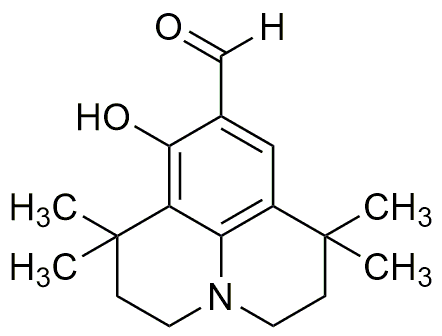8-Hydroxy-1,1,7,7-tetramethyljulolidine-9-carboxaldehyde is widely utilized in research focused on:
- Fluorescent Probes: This compound serves as a key component in developing fluorescent probes for biological imaging, allowing researchers to visualize cellular processes in real-time.
- Photodynamic Therapy: It is employed in photodynamic therapy applications, where its properties help in targeting and destroying cancer cells when activated by light.
- Organic Synthesis: The compound is used in organic synthesis as an intermediate, facilitating the creation of complex molecules in pharmaceuticals and agrochemicals.
- Sensor Technology: Its unique optical properties make it suitable for use in sensor technology, particularly for detecting environmental pollutants or biological markers.
- Research in Material Science: The compound is explored in material science for developing new materials with specific optical characteristics, enhancing the performance of devices like LEDs and solar cells.
General Information
Properties
Safety and Regulations
Applications
8-Hydroxy-1,1,7,7-tetramethyljulolidine-9-carboxaldehyde is widely utilized in research focused on:
- Fluorescent Probes: This compound serves as a key component in developing fluorescent probes for biological imaging, allowing researchers to visualize cellular processes in real-time.
- Photodynamic Therapy: It is employed in photodynamic therapy applications, where its properties help in targeting and destroying cancer cells when activated by light.
- Organic Synthesis: The compound is used in organic synthesis as an intermediate, facilitating the creation of complex molecules in pharmaceuticals and agrochemicals.
- Sensor Technology: Its unique optical properties make it suitable for use in sensor technology, particularly for detecting environmental pollutants or biological markers.
- Research in Material Science: The compound is explored in material science for developing new materials with specific optical characteristics, enhancing the performance of devices like LEDs and solar cells.
Documents
Safety Data Sheets (SDS)
The SDS provides comprehensive safety information on handling, storage, and disposal of the product.
Product Specification (PS)
The PS provides a comprehensive breakdown of the product’s properties, including chemical composition, physical state, purity, and storage requirements. It also details acceptable quality ranges and the product's intended applications.
Certificates of Analysis (COA)
Search for Certificates of Analysis (COA) by entering the products Lot Number. Lot and Batch Numbers can be found on a product’s label following the words ‘Lot’ or ‘Batch’.
Número de catálogo
Número de lote/lote
Certificates Of Origin (COO)
This COO confirms the country where the product was manufactured, and also details the materials and components used in it and whether it is derived from natural, synthetic, or other specific sources. This certificate may be required for customs, trade, and regulatory compliance.
Número de catálogo
Número de lote/lote
Safety Data Sheets (SDS)
The SDS provides comprehensive safety information on handling, storage, and disposal of the product.
DownloadProduct Specification (PS)
The PS provides a comprehensive breakdown of the product’s properties, including chemical composition, physical state, purity, and storage requirements. It also details acceptable quality ranges and the product's intended applications.
DownloadCertificates of Analysis (COA)
Search for Certificates of Analysis (COA) by entering the products Lot Number. Lot and Batch Numbers can be found on a product’s label following the words ‘Lot’ or ‘Batch’.
Número de catálogo
Número de lote/lote
Certificates Of Origin (COO)
This COO confirms the country where the product was manufactured, and also details the materials and components used in it and whether it is derived from natural, synthetic, or other specific sources. This certificate may be required for customs, trade, and regulatory compliance.


